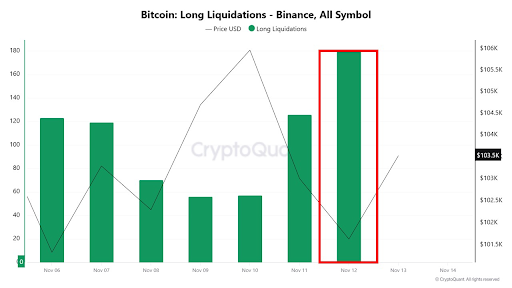- Binance experienced one of the highest long liquidation spikes in recent days, reflecting heavy leverage and rapid unwinding of positions.
- Bitcoin’s drop involved multiple cascading liquidation waves, creating a broad deleveraging event despite the anticipated U.S. government shutdown resolution.
- Weak ETF inflows and rising dollar pressures limited spot demand, increasing Bitcoin’s exposure to volatility triggered by liquidation dynamics.
Bitcoin fell below $103,000 on November 12, triggering one of the largest waves of long liquidations on Binance as leveraged positions were rapidly unwound.
Massive Long Liquidations Emerge on Binance
Binance recorded one of the most intense liquidation surges in recent days as Bitcoin’s decline accelerated. Data from XWIN Research Japan shows that the exchange saw a sharp spike in daily liquidations, marking one of the highest levels in the past ten days. The market had become heavily skewed toward long positions, amplifying the sell pressure once support levels were breached.

Multiple liquidation waves swept across the market throughout the day. While reports mentioned more than $120 million in liquidations within an hour, the broader data revealed a day-long deleveraging process. Each successive breach of technical support triggered forced position closures, setting off a chain reaction of selling. This cascading effect intensified volatility and drove Bitcoin lower.
JAVONMARKS, a market analyst on X, noted that such liquidation events often follow periods of heavy leverage buildup. Binance’s dominance in derivatives trading made it the focal point of this deleveraging phase, exposing the fragility of the highly leveraged market environment.
Price Weakness Despite Positive Government Developments
The volatile price fluctuation occurred in conjunction with news of a potential resolution for the U.S. government shutdown. When action like this occurs, it would usually be bullish for the market sentiment but traders did the reverse. The market was aware that a positive development was expected so the market reaction was tempered with a slight “sell-the-news” response.
At the same time, an increase in the U.S. dollar index and a rise in longer-duration Treasury yields were not supportive of buying. This macro change happened at the best time when any liquidity would have been most useful in supporting the price. The stronger dollar and yields diverted risk appetite away from Bitcoin and other digital assets, limiting recovery attempts.
The timing of these macro pressures contributed to the intensity of the liquidation wave. Traders who had entered leveraged long positions before the resolution found themselves trapped as support levels failed to hold under mounting sell pressure.
ETF Flows and Market Structure Maintain a Constructive Outlook
Institutional demand through Bitcoin exchange-traded funds has remained soft in recent sessions. This lack of consistent inflows reduced the spot market’s ability to absorb selling volume during the liquidation phase. Without sustained ETF demand, the market became more susceptible to volatility driven by leverage adjustments.
However, analysts at XWIN Research Japan emphasized that the decline was not rooted in weakening fundamentals. Instead, it stemmed from excessive leverage, cascading liquidations, and temporary macro headwinds. Once these conditions stabilize, the broader market setup remains steady.
Market observers believe that as the deleveraging phase completes, Bitcoin’s structural outlook could recover, supported by ongoing institutional participation and improved liquidity conditions. Binance’s liquidation surge serves as a reminder of how leverage concentration can amplify short-term market moves, even in a generally constructive environment.





